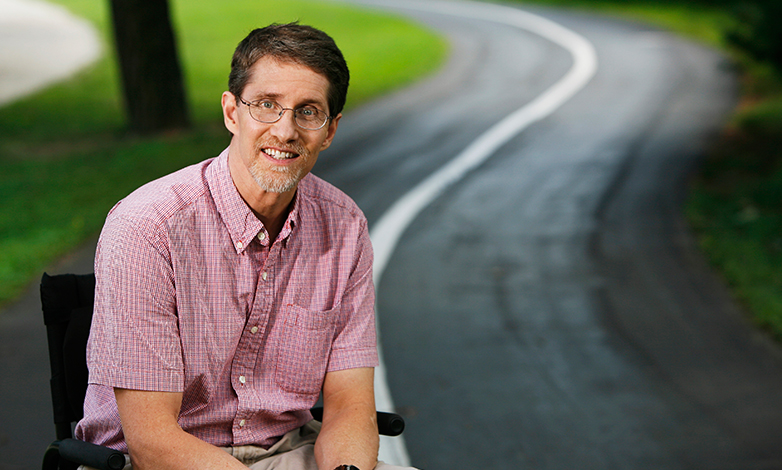Lectureship Spotlight: Ross C. Brownson, PhD
Published: April 9, 2019

About the Michael & Susan Dell Center Lectureship in Child Health:
The Michael & Susan Dell Center Lectureship in Child Health is an annual event held in Austin each spring to recognize distinguished researchers who have made outstanding contributions to child health. The Lectureship is an academic forum to increase research capacity and partnerships within the Texas community, and provides visibility for senior scientists in the fields of child health and obesity prevention. Since its inception in 2007, the annual Lectureship has honored a broad range of prominent national and international child health experts, whose research areas have included healthful eating, obesity prevention, physical activity, food policy, and community and youth development. This year we recognize Ross C. Brownson, PhD, a leading expert in the areas of chronic disease prevention and applied epidemiology.
About Ross C. Brownson, PhD:
Dr. Brownson is the Lipstein Distinguished Professor of Public Health at Washington University in St. Louis. He studies the translation of evidence to public health practice and policy, with a content focus on environmental and policy determinants of chronic diseases. Dr. Brownson is the author of numerous books and over 500 peer-reviewed articles. He has received numerous awards for his work. Among these, he is the recipient of the American Public Health Association’s (APHA) Abraham Lilienfeld Award for excellence in teaching and mentoring (2003) and the APHA Award for Excellence (2016). Dr. Brownson is a former president of the American College of Epidemiology and the National Association of Chronic Disease Directors.
Q&A with Dr. Brownson:
As a teaser for the Lectureship, we asked Dr. Brownson a few questions. See what he answered below:
What are the main contributors to declining rates of physical activity in the United States and in Texas?
We have examined long-term trends in physical activity, which is a complex, multi-domain behavior. We found relatively stable or slightly increasing levels of leisure-time physical activity, declining work-related activity, declining transportation activity, declining activity in the home, and increasing sedentary activity. These “sub-trends” lead to an overall trend of declining total physical activity. Although it is difficult to precisely quantify due to the lack of long-term data, it is apparent that a combination of changes to the built environment and increases in the proportion of the population engaging in sedentary activities put the majority of the American and Texas population at high risk of physical inactivity. A set of evidence-based interventions in the CDC Community Guide are likely to shift the declining rate of physical activity in a positive direction.
What factors are contributing to the sparse uptake of evidence-based interventions?
There is a sparse uptake of evidence-based interventions and public health practice, and in my experience, both as a public health practitioner and then for the last fifteen years or so, as a researcher, there are several key factors. I think one factor that leads to the sparse uptake is the lack of incentives. Many public health agencies don't have the right incentives in place to encourage people to use evidence-based practices. Another is that the leadership of an agency, or the leadership of someone in the position to really drive the decision making around evidence-based practices, may not see it as a priority. They may not have any background in some health related field, and the third one, I think, is very much related to the second, that is, the training in public health practice. Many people wouldn't know this, but most people out working in day-to-day public health have no formal training in public health, and so, the idea that we're going to encourage people to use evidence-based practices and make those part of their day-to-day work is hard if someone has no training in epidemiology or health education or evaluation, and so I think that's another key factor as to why we don't see the amount of uptake of evidence-based interventions that we would like to see.
What can researchers do to improve research dissemination and implementation?
If researchers more fully follow the principles of dissemination and implementation (D&I) science, we would close the long gap between discovery of new knowledge and application of this knowledge in practice and policy settings. The process starts with following principles of designing for dissemination (D4D). D4D is the process of ensuring that evidence-based interventions are developed in ways that match well with adopters’ needs, assets, and time frames. We can learn from participatory research to understand how an intervention is received by a population, and how you engage the population in the research process. We need to more fully and creatively target dissemination to specific audiences, and in doing so we need to identify key audiences for dissemination, understand how those audiences receive, process, and use research evidence, and develop new strategies for reaching these audiences.
Learn more about Dr. Brownson’s work at the 2019 Michael & Susan Dell Center Lectureship in Child Health on April 23rd in Austin, Texas, located at the Blanton Museum of Art. Details are available at childhealthlectureship.org.



Discussion